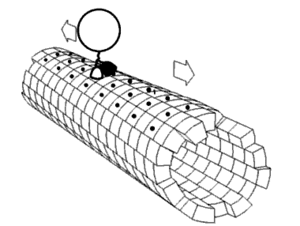
Back روبوتات نانوية Arabic Наноботика Bulgarian Nanorobotika BS Nanorobòtica Catalan Nanoroboteg Welsh Νανορομποτική Greek Nanorrobótica Spanish Nanorobootika Estonian Nanorobotika Basque نانوروباتیک Persian
| Part of a series of articles on |
| Molecular nanotechnology |
|---|

| Part of a series of articles on |
| Nanotechnology |
|---|
| Impact and applications |
| Nanomaterials |
| Molecular self-assembly |
| Nanoelectronics |
| Nanometrology |
| Molecular nanotechnology |
Nanoid robotics, or for short, nanorobotics or nanobotics, is an emerging technology field creating machines or robots, which are called nanorobots or simply nanobots, whose components are at or near the scale of a nanometer (10−9 meters).[1][2][3] More specifically, nanorobotics (as opposed to microrobotics) refers to the nanotechnology engineering discipline of designing and building nanorobots with devices ranging in size from 0.1 to 10 micrometres and constructed of nanoscale or molecular components.[4][5] The terms nanobot, nanoid, nanite, nanomachine and nanomite have also been used to describe such devices currently under research and development.[6][7]
Nanomachines are largely in the research and development phase,[8] but some primitive molecular machines and nanomotors have been tested. An example is a sensor having a switch approximately 1.5 nanometers across, able to count specific molecules in the chemical sample. The first useful applications of nanomachines may be in nanomedicine. For example,[9] biological machines could be used to identify and destroy cancer cells.[10][11] Another potential application is the detection of toxic chemicals, and the measurement of their concentrations, in the environment. Rice University has demonstrated a single-molecule car developed by a chemical process and including Buckminsterfullerenes (buckyballs) for wheels. It is actuated by controlling the environmental temperature and by positioning a scanning tunneling microscope tip.
Another definition[12][13][14] is a robot that allows precise interactions with nanoscale objects, or can manipulate with nanoscale resolution. Such devices are more related to microscopy or scanning probe microscopy, instead of the description of nanorobots as molecular machines. Using the microscopy definition, even a large apparatus such as an atomic force microscope can be considered a nanorobotic instrument when configured to perform nanomanipulation. For this viewpoint, macroscale robots or microrobots that can move with nanoscale precision can also be considered nanorobots.
- ^ Vaughn JR (2006). "Over the Horizon: Potential Impact of Emerging Trends in Information and Communication Technology on Disability Policy and Practice". National Council on Disability, Washington DC: 1–55.
- ^ Ghosh, A.; Fischer, P. (2009). "Controlled Propulsion of Artificial Magnetic Nanostructured Propellers". Nano Letters. 9 (6): 2243–2245. Bibcode:2009NanoL...9.2243G. doi:10.1021/nl900186w. PMID 19413293.
- ^ Sierra, D. P.; Weir, N. A.; Jones, J. F. (2005). "A review of research in the field of nanorobotics" (PDF). U.S. Department of Energy – Office of Scientific and Technical Information Oak Ridge, TN. SAND2005-6808: 1–50. doi:10.2172/875622. OSTI 875622.
- ^ Tarakanov, A. O.; Goncharova, L. B.; Tarakanov Y. A. (2009). "Carbon nanotubes towards medicinal biochips". Wiley Interdisciplinary Reviews: Nanomedicine and Nanobiotechnology. 2 (1): 1–10. doi:10.1002/wnan.69. PMID 20049826.
- ^ Ignatyev, M. B. (2010). "Necessary and sufficient conditions of nanorobot synthesis". Doklady Mathematics. 82 (1): 671–675. doi:10.1134/S1064562410040435. S2CID 121955001.
- ^ Cerofolini, G.; Amato, P.; Asserini, M.; Mauri, G. (2010). "A Surveillance System for Early-Stage Diagnosis of Endogenous Diseases by Swarms of Nanobots". Advanced Science Letters. 3 (4): 345–352. doi:10.1166/asl.2010.1138.
- ^ Yarin, A. L. (2010). "Nanofibers, nanofluidics, nanoparticles and nanobots for drug and protein delivery systems". Scientia Pharmaceutica Central European Symposium on Pharmaceutical Technology. 78 (3): 542. doi:10.3797/scipharm.cespt.8.L02.
- ^ Wang, J. (2009). "Can Man-Made Nanomachines Compete with Nature Biomotors?". ACS Nano. 3 (1): 4–9. doi:10.1021/nn800829k. PMID 19206241.
- ^ Amrute-Nayak, M.; Diensthuber, R. P.; Steffen, W.; Kathmann, D.; Hartmann, F. K.; Fedorov, R.; Urbanke, C.; Manstein, D. J.; Brenner, B.; Tsiavaliaris, G. (2010). "Targeted Optimization of a Protein Nanomachine for Operation in Biohybrid Devices". Angewandte Chemie. 122 (2): 322–326. Bibcode:2010AngCh.122..322A. doi:10.1002/ange.200905200. PMID 19921669.
- ^ Patel, G. M.; Patel, G. C.; Patel, R. B.; Patel, J. K.; Patel, M. (2006). "Nanorobot: A versatile tool in nanomedicine". Journal of Drug Targeting. 14 (2): 63–67. doi:10.1080/10611860600612862. PMID 16608733. S2CID 25551052.
- ^ Balasubramanian, S.; Kagan, D.; Jack Hu, C. M.; Campuzano, S.; Lobo-Castañon, M. J.; Lim, N.; Kang, D. Y.; Zimmerman, M.; Zhang, L.; Wang, J. (2011). "Micromachine-Enabled Capture and Isolation of Cancer Cells in Complex Media". Angewandte Chemie International Edition. 50 (18): 4161–4164. doi:10.1002/anie.201100115. PMC 3119711. PMID 21472835.
- ^ Langer, Robert (2010). "Nanotechnology in Drug Delivery and Tissue Engineering: From Discovery to Applications". Nano Lett. 10 (9): 3223–30. Bibcode:2010NanoL..10.3223S. doi:10.1021/nl102184c. PMC 2935937. PMID 20726522.
- ^ Callaway DJ, Nicholl ID, Shi B, Reyes G, Farago B, Bu Z (2024). "Nanoscale dynamics of the cadherin-catenin complex bound to vinculin revealed by neutron spin echo spectroscopy". Proceedings of the National Academy of Sciences of the United States of America. 129 (39). doi:10.1073/pnas.2408459121. PMID 39298480.
- ^ Ehud Gazit, Plenty of room for biology at the bottom: An introduction to bionanotechnology. Imperial College Press, 2007, ISBN 978-1-86094-677-6